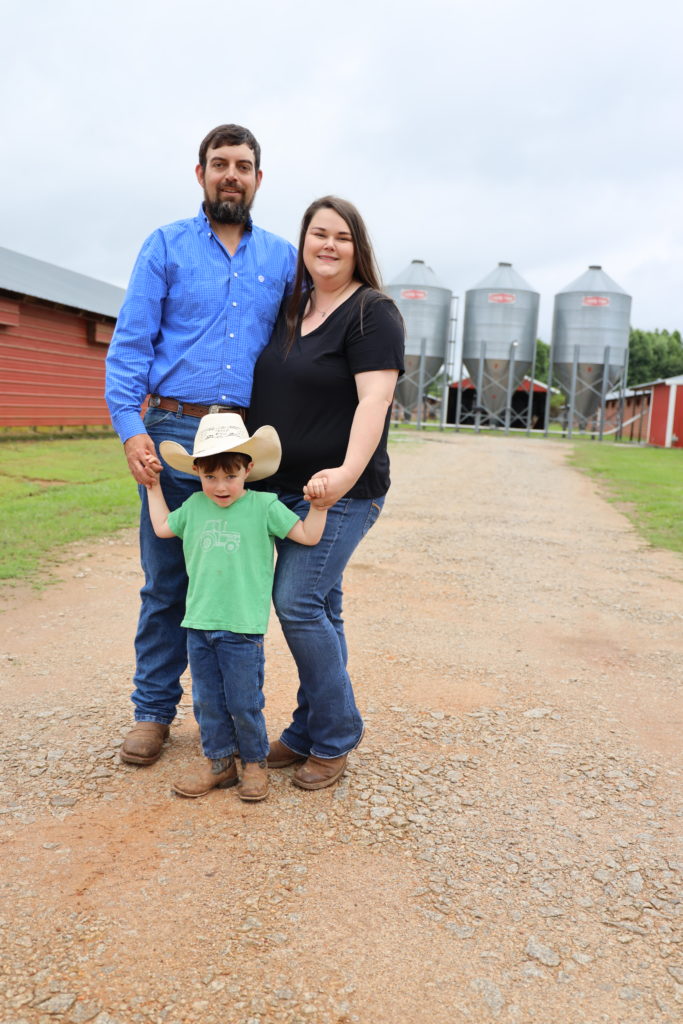Down To Earth: Alabama Farmers Grow More While Using Less

By Marlee Moore
Growing more. Using less. For farmers, it’s just that simple.
“A lot of data is out there to help us make decisions to improve factors we can control on the farm,” said Jordyn Upchurch, who raises poultry, cattle and hay with husband Chris in Clay County.
For years, farmers and industry experts have analyzed that data to select superior traits in plants and animals. That’s created innately efficient crops and livestock that glean higher yields with fewer inputs.
Take the poultry industry. Today, it takes 1.82 pounds of feed to produce 1 pound of chicken. Fifty years ago, that required 2.4 pounds of feed, per the National Chicken Council. Chickens are humanely and efficiently grown in houses, which saves water and energy — a boon in Alabama’s hot climate.
A low feed conversion rate and high average daily gains help farmers like the Upchurches raise more flocks, providing more protein for a growing population.
The U.S. is a global leader in beef production efficiency, too, producing 18% of the world’s beef with only 6% of the world’s cattle, according to the Beef Checkoff.
Thanks to improved genetics, nutrition and herd management, U.S. farmers produce more beef per animal. Today, farmers produce the same amount of beef with one-third fewer cattle than in 1977.
Farmers also pinpoint cattle breeds ideal for their farms and consider heat tolerance, mothering ability, weaning weights, yields and even what grass the animals can digest.
“We pick them for what works in our environment,” said Chris, who raises SimAngus cattle. “We have a lot of fescue grass (which has a seasonal toxicity), so we need animals that work in a fescue environment.”
Jordyn added, “And that makes our cattle more efficient. It’s hard to change what kind of grass grows on your place, but you can change your genetics. It’s almost like a process of elimination.”
Other than delicious and nutritious steaks, roasts and burgers, there are hundreds of uses for cattle byproducts — asphalt, ink, dyes, adhesives, plastics and more.
That waste-not-want-not outlook links row crop and livestock farmers. More than 95% of poultry bedding material is recycled and reused to fertilize hayfields or land for row crops, like cotton. Cotton lint, or fiber, is then made into clothes, towels and dollar bills. Meanwhile, cottonseed is used for oil and cattle feed because it’s rich in fiber, protein and fat.
Brian Glenn and his brother, Don, raise row crops in Lawrence and Morgan counties. They capitalize on biotechnology, such as genetic modification, to reduce costly inputs and improve weed management. Roughly 90% of corn, cotton and soybeans grown in the U.S. have been improved through biotechnology.
“Genetics have changed so much,” Brian said. “The potential is in the seed.”
Twenty-five years ago, the Glenns shot for a yield of 130 bushels per acre on corn. Today, they’re able to harvest 200 bushels an acre. Tools like variable rate technology help. Variable rate farming requires machinery that changes the rate at which it applies fertilizer, seed and other inputs across a field based on need.
“We are spoon-feeding plants,” Brian said. “We take last year’s yield map (or an average of several years) and calculate the removal of ingredients a plant will need to grow. That’s what we base our rates on.”
Data banks and a penchant for sustainable production helped farmers nearly triple production over the last 70 years, while inputs like land, fertilizer and energy have remained stable, according to the American Farm Bureau Federation.
In 1990, farmers would have needed almost 100 million additional acres to harvest the same amount of corn, cotton, rice, soybeans and wheat produced in 2018. That’s more than the land area of Montana.
As Brian looks across fields of non-irrigated, no-till corn and soybeans, he said he’s proud of the strides farmers continually make to efficiently use — and protect — the land.
“My goal is to leave the planet better than we found it, to make a living and ensure a wholesome, quality food crop,” Brian said.
